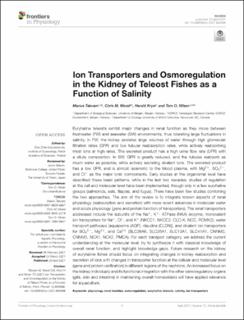| dc.description.abstract | Euryhaline teleosts exhibit major changes in renal function as they move between freshwater (FW) and seawater (SW) environments, thus tolerating large fluctuations in salinity. In FW, the kidney excretes large volumes of water through high glomerular filtration rates (GFR) and low tubular reabsorption rates, while actively reabsorbing most ions at high rates. The excreted product has a high urine flow rate (UFR) with a dilute composition. In SW, GFR is greatly reduced, and the tubules reabsorb as much water as possible, while actively secreting divalent ions. The excreted product has a low UFR, and is almost isosmotic to the blood plasma, with Mg2+, SO42–, and Cl– as the major ionic components. Early studies at the organismal level have described these basic patterns, while in the last two decades, studies of regulation at the cell and molecular level have been implemented, though only in a few euryhaline groups (salmonids, eels, tilapias, and fugus). There have been few studies combining the two approaches. The aim of the review is to integrate known aspects of renal physiology (reabsorption and secretion) with more recent advances in molecular water and solute physiology (gene and protein function of transporters). The renal transporters addressed include the subunits of the Na+, K+- ATPase (NKA) enzyme, monovalent ion transporters for Na+, Cl–, and K+ (NKCC1, NKCC2, CLC-K, NCC, ROMK2), water transport pathways [aquaporins (AQP), claudins (CLDN)], and divalent ion transporters for SO42–, Mg2+, and Ca2+ (SLC26A6, SLC26A1, SLC13A1, SLC41A1, CNNM2, CNNM3, NCX1, NCX2, PMCA). For each transport category, we address the current understanding at the molecular level, try to synthesize it with classical knowledge of overall renal function, and highlight knowledge gaps. Future research on the kidney of euryhaline fishes should focus on integrating changes in kidney reabsorption and secretion of ions with changes in transporter function at the cellular and molecular level (gene and protein verification) in different regions of the nephrons. An increased focus on the kidney individually and its functional integration with the other osmoregulatory organs (gills, skin and intestine) in maintaining overall homeostasis will have applied relevance for aquaculture. | en_US |

